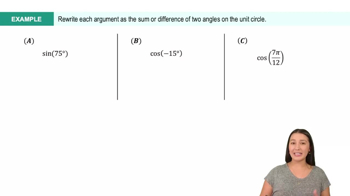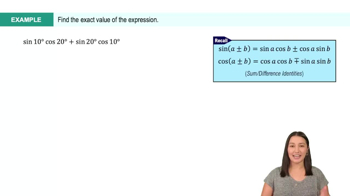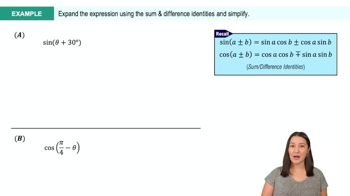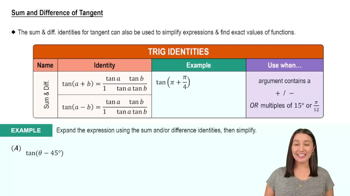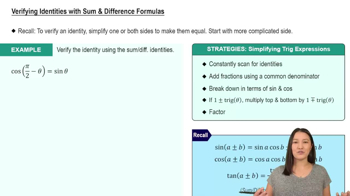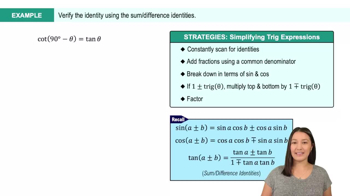Table of contents
- 0. Review of College Algebra4h 43m
- 1. Measuring Angles39m
- 2. Trigonometric Functions on Right Triangles2h 5m
- 3. Unit Circle1h 19m
- 4. Graphing Trigonometric Functions1h 19m
- 5. Inverse Trigonometric Functions and Basic Trigonometric Equations1h 41m
- 6. Trigonometric Identities and More Equations2h 34m
- 7. Non-Right Triangles1h 38m
- 8. Vectors2h 25m
- 9. Polar Equations2h 5m
- 10. Parametric Equations1h 6m
- 11. Graphing Complex Numbers1h 7m
6. Trigonometric Identities and More Equations
Sum and Difference Identities
Problem 5.12b
Textbook Question
Find the exact value of each expression.
tan 285°
 Verified step by step guidance
Verified step by step guidance1
First, recognize that \( 285^\circ \) can be expressed as \( 360^\circ - 75^\circ \). This means we can use the identity for tangent of a difference: \( \tan(360^\circ - \theta) = -\tan(\theta) \).
Apply the identity: \( \tan(285^\circ) = \tan(360^\circ - 75^\circ) = -\tan(75^\circ) \).
Next, express \( 75^\circ \) as a sum of angles whose tangent values are known: \( 75^\circ = 45^\circ + 30^\circ \).
Use the tangent sum identity: \( \tan(\alpha + \beta) = \frac{\tan \alpha + \tan \beta}{1 - \tan \alpha \tan \beta} \), where \( \alpha = 45^\circ \) and \( \beta = 30^\circ \).
Substitute the known values: \( \tan(45^\circ) = 1 \) and \( \tan(30^\circ) = \frac{1}{\sqrt{3}} \), then calculate \( \tan(75^\circ) \) using the formula, and finally find \( \tan(285^\circ) = -\tan(75^\circ) \).
Recommended similar problem, with video answer:
 Verified Solution
Verified SolutionThis video solution was recommended by our tutors as helpful for the problem above
Video duration:
0m:0sPlay a video:
Was this helpful?
Key Concepts
Here are the essential concepts you must grasp in order to answer the question correctly.
Unit Circle
The unit circle is a fundamental concept in trigonometry that defines the relationship between angles and the coordinates of points on a circle with a radius of one. Each angle corresponds to a point on the circle, where the x-coordinate represents the cosine of the angle and the y-coordinate represents the sine. Understanding the unit circle is essential for evaluating trigonometric functions at various angles, including those greater than 360°.
Recommended video:

Introduction to the Unit Circle
Reference Angles
A reference angle is the acute angle formed by the terminal side of an angle and the x-axis. It is used to simplify the calculation of trigonometric functions for angles in different quadrants. For example, to find tan 285°, we can determine its reference angle, which is 360° - 285° = 75°, and then use the properties of tangent in the fourth quadrant to find the exact value.
Recommended video:

Reference Angles on the Unit Circle
Tangent Function
The tangent function is defined as the ratio of the sine to the cosine of an angle, or tan(θ) = sin(θ) / cos(θ). It is periodic with a period of 180°, meaning that tan(θ) = tan(θ + 180°). Understanding how to compute the tangent of an angle using the unit circle and reference angles is crucial for finding exact values, especially for angles like 285° that are not commonly found in basic trigonometric tables.
Recommended video:

Introduction to Tangent Graph

 6:14m
6:14mWatch next
Master Sum and Difference of Sine & Cosine with a bite sized video explanation from Callie Rethman
Start learningRelated Videos
Related Practice



